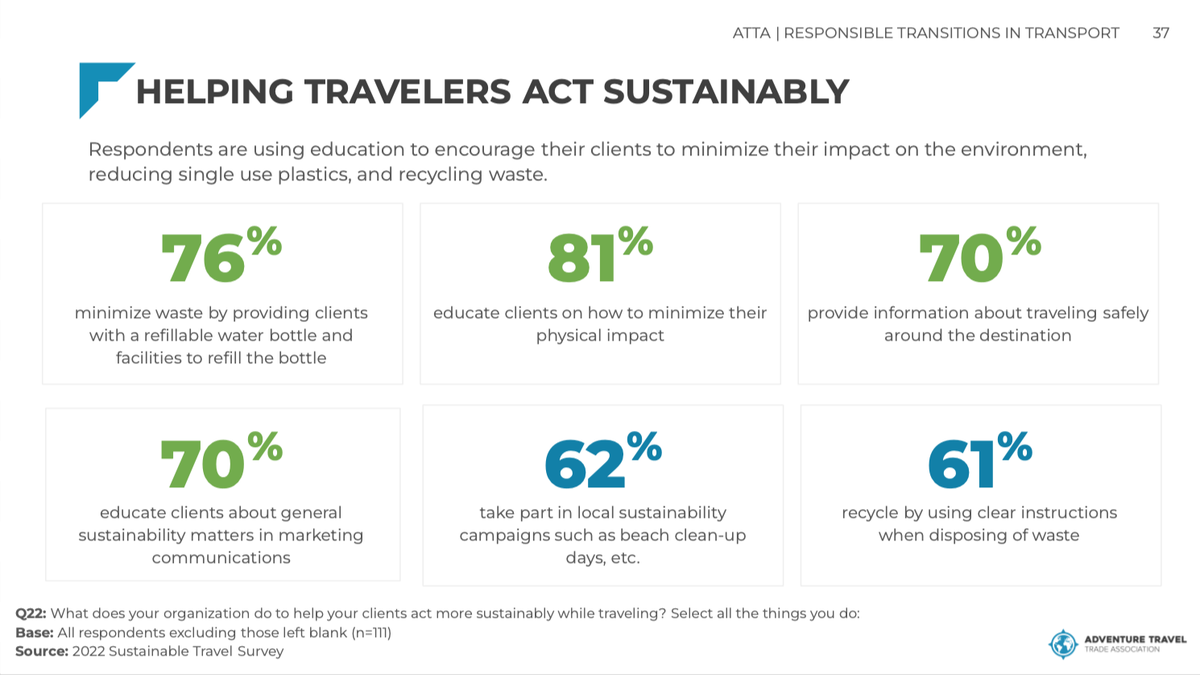Pre-COVID-19, Travel and Tourism was the third largest industry globally, accounting for 8% of the world’s carbon emissions. As travel recovers from the pandemic, the growing tourism numbers continue to have a significant impact on the environment. As one of the key components of travel is people getting from one place to another, it does not come as a surprise that transportation is the most significant contributor to the greenhouse gas emissions in the industry, accounting for 49% to 75% of the overall emissions generated in the industry.
Although all modes of transportation like planes, cars, trains, and boats succeed in the ultimate goal of enabling travelers to explore the world, there are significant differences in the carbon footprint based on the transportation type. Therefore, the Adventure Travel Trade Association (ATTA) and Switzerland Tourism have collaborated on a research project on how public transportation is currently utilized in adventure travel itineraries, what kind of difficulties are faced by industry professionals, and what could be done better, with the purpose of helping adventure industry companies better understand public transportation as a component of the tourism ecosystem.
Download the Report Here
Report highlights:
- In 2019, 59% of the 1.5 billion international tourist arrivals used air travel as their mode of transportation to arrive in their destination, followed by road travel at 35%.
- While a large traditional city bus is estimated to have a relatively high level of emissions per passenger compared to other methods, a coach bus (like those typically used by adventure travel tour companies) is actually more efficient than traveling by domestic rail.
- 53% of survey respondents agree they need to work on changing to more sustainable means of transport, and it’s a priority for the next 12 months.
- Primary challenges with public transport: 67% said there is a lack of physical infrastructure to use public transport at their destination and 37% responded that their clients are not interested in taking public transportation.
- A small number of companies give discounts on public transportation tickets or offer creative incentives to travelers who utilize public transportation on their itineraries.
- When considering itineraries, companies with women leaders are significantly less likely to offer itineraries that only use public transportation, and slightly more likely to use public transportation in parts of certain itineraries. This may be due to inherent heightened concerns about safety.
- Destinations are considering not only how to get from A to B via train but also special touches, such as "green cars" in Japan serving regionally unique food, and Switzerland’s high level of intensity of use, quality of service, and safety.
Download the Report Here
This report discusses many of the common transportation methods adventure travelers use to arrive at and travel within their destination. While some modes of transportation are more detrimental to the environment than others, there is no one-size-fits-all solution to implement environmentally friendly transportation in all locations. Even when public transport is available, it is not always wide-reaching, reliable, safe, or clean. However, it is time for the adventure travel community to take a good look at the transportation used in their itineraries, to see if more environmentally friendly alternatives are available.
Survey Respondents Are Taking Action
- 89% think about how to reduce environmental impact when creating itineraries.
- 53% agree they need to work on changing to more sustainable means of transport & it’s a priority for the next 12 months.
- 51% like using public transportation in the itineraries offered for travelers.
- 31% try to avoid public transportation when creating itineraries; this means 69% are willing to include it in the right scenarios.
- Respondents are using education to encourage their clients to minimize their impact on the environment, reducing single use plastics, and recycling waste.
- Conversely, efforts to help travelers use public transportation are not popular, likely due to a lack of availability of reliable, efficient, and safe public transport methods.

As identified in the survey, some major challenges of incorporating public transport into itineraries include a lack of buy-in from destination stakeholders, and a low level of interest from some groups of travelers. Public transportation can relieve some pressure from car-heavy destinations, reducing parking infrastructure needs, traffic congestion, and pollution. It can make travel available and accessible to a wider number of people. Operators can encourage their clients to use public transportation if it is available and practical in their situation by utilizing special offers and incentives. Customers need to first be shown the benefits of using public transport (convenience, easy luggage transfers as in Switzerland, low price, etc.), and then messaging should reinforce environmental benefits.

The good news is, the adventure travel community is ready to rise to the challenge, with 89% of respondents thinking about how to reduce environmental impact when creating itineraries. Twenty-six percent of respondents already inform their clients about the availability of more sustainable forms of travel for arrival and within the destination, and 69% are willing to incorporate public transport in their itineraries. Just over half (53%) agree they need to work on changing to more sustainable means of transport and are making it a priority for the next 12 months. All of these efforts prove that adventure travel is moving in the right direction toward traveling more sustainably and reducing the tourism industry’s impact on the environment.
